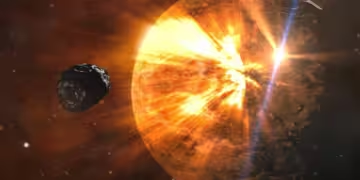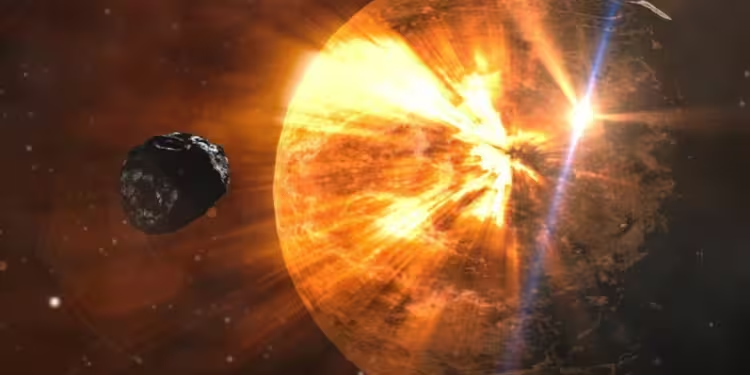Comets, those icy travelers from the far reaches of our solar system, are more than just spectacular celestial displays. They hold the keys to unlocking the mysteries of our solar system’s formation and evolution. Let’s reveal how these cosmic clues are reshaping our understanding of the solar system’s early history and what they mean for future exploration.
Key Findings of the Study on Comet Disintegration
A groundbreaking study published in Icarus has uncovered that comets do not disintegrate uniformly when nearing the Sun; instead, their breakup is influenced by their birth conditions in the solar system’s protoplanetary disk. An international team of 45 researchers, led by Peter Jenniskens, a meteor astronomer at the SETI Institute and NASA Ames, studied the varying disintegration patterns of comets. They discovered that the way comets crumble into meteoroids—the small particles that create meteor showers when they enter Earth’s atmosphere—depends on where and how they formed.
The evidence for this discovery comes from examining 47 young meteor showers and analyzing the meteoroids’ physical and chemical properties. These findings are critical because they suggest that the diversity in meteor showers is directly linked to the different regions in the early solar system where comets originated. This study challenges our understanding of comet composition and reveals that not all comets are created equal. Understanding these differences is essential for piecing together the puzzle of our solar system’s formation.
Formation of Comets in the Protoplanetary Disk
The way comets formed in the protoplanetary disk around the young Sun is crucial to understanding their current behavior as they approach the Sun. In the early solar system, tiny particles in the disk gradually collided and stuck together, forming larger bodies known as “pebbles.” According to Paul Estrada, a planetary scientist at NASA Ames and co-author of the study, these pebbles eventually grew large enough to avoid being destroyed by collisions, leading to the formation of comets and primitive asteroids.
The evidence of this process is found in the current characteristics of meteoroids from different comets. Comets from the Oort Cloud, which formed farther from the Sun, tend to disintegrate gently, producing low-density meteoroids. In contrast, comets from the Kuiper Belt, closer to the Sun, formed under more aggressive conditions, resulting in denser and more fragmented meteoroids. These differences in meteoroid properties provide a window into the early solar system’s dynamic environment, where the location and conditions of formation significantly influenced the characteristics of these celestial bodies.
Analysis of Meteor Showers and Meteoroid Composition
Understanding how comets disintegrate into meteoroids helps us better predict meteor showers and their potential impact on Earth. Using advanced meteor tracking techniques, such as the NASA-sponsored Cameras for Allsky Meteor Surveillance (CAMS) network, researchers were able to closely monitor meteoroids as they entered Earth’s atmosphere. These specialized low-light cameras measured the meteoroids’ paths, the height at which they first lit up, and how they slowed down, providing a wealth of data on their size, density, and composition.
The study revealed that meteoroids from long-period comets, like those from the Oort Cloud, have a relatively constant low density and are often poor in sodium—a characteristic that distinguishes them from meteoroids originating from Jupiter-family comets. On the other hand, Jupiter-family comets, which come from the Scattered Disk of the Kuiper Belt, tend to break down into smaller, denser meteoroids with a higher content of solid materials. These variations offer a direct link between the physical and chemical properties of meteoroids and the unique environments where their parent comets formed.
Implications for Understanding the Solar System’s Evolution
The study’s findings have far-reaching implications for our understanding of the solar system’s evolution. The distinct fragmentation patterns and compositions of meteoroids from different comets suggest that the early solar system was a highly dynamic and chaotic environment. As Neptune migrated outward during the solar system’s early years, it scattered comets and asteroids from the protoplanetary disk into regions like the Kuiper Belt and the Oort Cloud. This scattering process likely contributed to the formation of both the Scattered Disk and the Oort Cloud.
The significance of these findings is that they help astronomers predict the behavior of comets and meteor showers today. By understanding how different comets break apart, scientists can better anticipate the characteristics of the meteor showers they produce, including their frequency, intensity, and potential risks to Earth. This research also adds depth to our knowledge of the solar system’s early history and the processes that shaped its current architecture.
Future Research and Exploration in Cometary Science
This study opens the door for further research into the composition and behavior of comets, particularly those from less-studied regions of the solar system. Future studies could use advanced space missions and telescopic technologies to delve deeper into the characteristics of these celestial bodies. For instance, new missions to the Kuiper Belt or Oort Cloud could provide direct observations of these comets, helping to confirm the theories proposed by Jenniskens and his team.
Moreover, upcoming missions like NASA’s Comet Interceptor could target a dynamically new comet from the Oort Cloud, providing an unprecedented opportunity to study these icy bodies up close. By understanding the formation and disintegration processes of comets better, scientists can refine their models of the solar system’s evolution and gain new insights into how planets and other celestial bodies came to be. This research could also inform our strategies for future space exploration, especially when it comes to protecting Earth from potential comet impacts.
Conclusion: Broader Impact of Comet Research
The recent study on comet disintegration patterns provides a fresh perspective on the formation and evolution of our solar system. By linking the physical and chemical properties of meteoroids to the conditions in the protoplanetary disk, researchers have uncovered new details about the diversity of cometary materials and meteor showers. These findings are not only crucial for understanding the history of our cosmic neighborhood but also for predicting future celestial events that could impact Earth.
As we continue to explore the secrets of comets and their origins, we gain a better understanding of the processes that shaped our solar system billions of years ago. With ongoing advancements in cometary science and new missions on the horizon, the quest to uncover the mysteries of our solar system’s early days is far from over. The knowledge gained from studying these ancient travelers will undoubtedly contribute to our broader understanding of planetary science and the universe itself.
Reference:
Jenniskens, P., Estrada, P. R., Pilorz, S., Gural, P. S., Samuels, D., Rau, S., Abbott, T. M. C., Albers, J., Austin, S., Avner, D., Baggaley, J. W., Beck, T., Blomquist, S., Boyukata, M., Breukers, M., Cooney, W., Cooper, T., De Cicco, M., Devillepoix, H., Egland, E., & Lauretta, D. S. (2024). Properties of outer solar system pebbles during planetesimal formation from meteor observations. Icarus. https://doi.org/10.1016/j.icarus.2024.116229



















